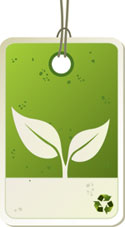It’s a tiny detail of everyday life: the packages things come wrapped in, and the ones we buy for putting them inside. If you take a trip to a big box store, or to shops that sell items in large quantity … or, well, any supermarket, drugstore or hardware store … okay, almost ANY store – and look around with plastic-seeking eyes and consider the billions of people doing the same thing…wow, that’s a lot o’ plastic.
All of that plastic is made with oil (close to one gallon per week for each of us). It is not biodegradable, it is toxic when burned, and when sitting in landfills, it leaches into soil and groundwater (excepting the small amount that is actually recycled and often made into products that probably will not be recycled). Approximately one-third of municipal waste is packaging.
This is a sad state, even if a tiny one, in the big country of life.
Some companies understand that consumers might be interested in considering packaging materials. Think of chip bags (billions) made of plastic and (mined) aluminum foil. Sun Chips from Frito Lay are now being produced in bags that are truly compostable under the right conditions, fashioned from the biopolymer Ingeo made from corn. “So you eat the chips. The earth eats the bag.”*
Naturally Iowa is one of a few small companies selling water in bottles also made with Ingeo. Stahlbush Island Farms in Oregon is using compostable packaging for frozen fruits and vegetables. More importantly, large plastics suppliers like Cargill (Natureworks), Cereplast and BASF and Asian suppliers are all working on non-fossil fuel-based plastics.
What about packaging we buy, for things like school and work lunches? Fortunately there are more choices than petroleum-based Tupperware and Ziploc plastics.
First, reuse bags whenever possible. Bags that held dry foods (such as cereals or grains) may not even need washing. While washing plastic bags is an okay solution, it can be water intensive and may require inconvenient amounts of space to dry properly. Other bags such as shopping or newspaper bags can be used if food is wrapped (in paper or cloth) before being placed inside.
Other alternatives include readily available wax paper bags. The small amount of wax in Natural Value bags is petroleum-based paraffin. If You Care makes soybean-based wax paper and natural kraft paper sandwich bags (found at Whole Foods). Two cool old-fashioned alternatives may need to be purchased online: Glassine bags are made of very fine paper, usually bleached; and true cellophane bags are made from wood pulp.
News flash: a new San Francisco company, Green Genius, makes biodegradable plastic zip-close bags for sandwiches and freezing. These contain recycled plastic and organic nutrients that feed on the plastic in the landfill, rendering them into biomass, CO2 and methane (true, we don’t need more of it, but that’s what waste does).
Choosing washable containers uses fewer resources. Reusable stainless steel food containers might be a better alternative to both plastic, which can contain BPA and other leachable chemicals and heavy and breakable glass. These are made by, among others, Lunchbots, Happy Tiffin (pictured), To-Go Ware and Thermos.
Soon, plastics may not be made from oil. While that is great, we need ask: Will there be enough other resources to produce the use-once-and-toss items we now demand? Or will that model, so twentieth century, also get tossed?
References
worldcentric.org
excellentpackaging.com/pages/1/EPSContact.html
nashvillewraps.com/foodpackaging/bakery-bags/c-049793.htm


